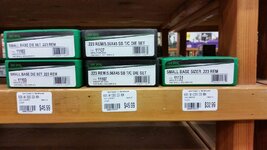- Messages
- 48
- Reactions
- 47
looking at .223 "sets"
I'm looking for a middle of the road option here, the dies range everywhere from $30~$200.
this is the set that i am getting ready to pull the trigger on
http://www.midwayusa.com/product/326499/redding-premium-series-deluxe-3-die-set-223-remington
I'm wondering if it is overkill, just right or not enough for my needs and what i am wanting.
I'm coming from the mindset of buy once cry once and that the vast majority of my .223 shooting is just plinking, more or less confined to me running around a field trying to be "tactical" like an idiot, on the the other hand i would like the ability to turn out some decent ammo in the rare instance that i do some shooting from a bench, i really don't need sub-moa match grade ammo in this caliber, but being able to do something somewhat close would be nice on occasion, when i say bench shooting I'm talking about taking a 4" gong and simply moving it out to a distance that becomes hard to hit for me personally from a bench with a bipod... I'm really not into punching paper with the rests and bags and all of that, reasonable/practical accuracy is enough for me out the .223...
what's a good all around die set that's easy to run but can be fiddled with to turn out some pretty decent stuff if needed?
i have a L&L AP and a LEE classic, so 5 stations +1 if that matters to the conversation, i understand this is an awkward question, I'm hoping to have a conversation to get a better understanding of the nitty gritty of it all, i fail to see the difference in the die sets once you get past the materials like carbide or not and the micometers and such... where's the value to performace curve at in the .223 die market?
thanks!
I'm looking for a middle of the road option here, the dies range everywhere from $30~$200.
this is the set that i am getting ready to pull the trigger on
http://www.midwayusa.com/product/326499/redding-premium-series-deluxe-3-die-set-223-remington
I'm wondering if it is overkill, just right or not enough for my needs and what i am wanting.
I'm coming from the mindset of buy once cry once and that the vast majority of my .223 shooting is just plinking, more or less confined to me running around a field trying to be "tactical" like an idiot, on the the other hand i would like the ability to turn out some decent ammo in the rare instance that i do some shooting from a bench, i really don't need sub-moa match grade ammo in this caliber, but being able to do something somewhat close would be nice on occasion, when i say bench shooting I'm talking about taking a 4" gong and simply moving it out to a distance that becomes hard to hit for me personally from a bench with a bipod... I'm really not into punching paper with the rests and bags and all of that, reasonable/practical accuracy is enough for me out the .223...
what's a good all around die set that's easy to run but can be fiddled with to turn out some pretty decent stuff if needed?
i have a L&L AP and a LEE classic, so 5 stations +1 if that matters to the conversation, i understand this is an awkward question, I'm hoping to have a conversation to get a better understanding of the nitty gritty of it all, i fail to see the difference in the die sets once you get past the materials like carbide or not and the micometers and such... where's the value to performace curve at in the .223 die market?
thanks!












